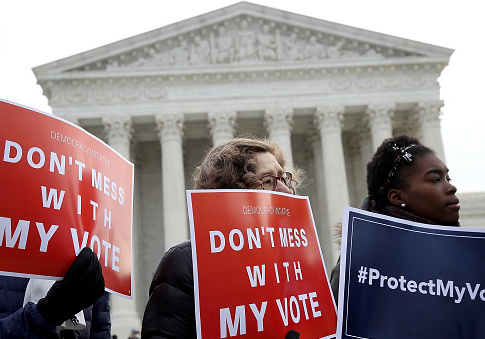The Supreme Court heard oral arguments Wednesday in an Ohio voting law case which pits supporters, who see the law as vital to preserving honest elections, against critics, who have attacked it as illegally disenfranchising thousands of Ohioans.
The case, Husted v. A. Philip Randolph Institute, focuses on Ohio's process for routinely clearing no-longer-eligible voters from its official lists. Every state does so, in order to ensure that would-be fraudulent voters cannot use the identities of people who have died or moved.
Ineligible voters in Ohio are identified by one of two ways: using the National Change of Address database, or through the "supplementary process."
It is the supplementary process that now faces legal scrutiny. Under current law, the Ohio Board of Elections compiles a list of registered voters who haven’t voted in the past two years. It sends a notice to those individuals, informing them of their inactivity. If notified Ohioans then either send their notices back, or vote at any point in the subsequent four years, they are kept on the roles. Otherwise, they are purged.
The question at stake is whether or not the supplementary process violates the National Voter Registration Act (NVRA) and the Help America Vote Act (HAVA), federal laws that govern voting rights and registration. The NVRA is designed to balance competing interests, intended as it is to "increase the number of eligible citizens who register to vote" and, simultaneously, to "ensure that accurate and current voter registration rolls are maintained." The supplementary process arguably supports the second goal, at the expense of the first.
Counsel for the challengers of the law—disenfranchised Ohio citizen Larry Harmon; the Ohio Coalition for the Homeless; and the Randolph Institute—contended that Ohio's notification process violates a portion of the NVRA preserved and clarified by a HAVA amendment that stipulates individual voters cannot be removed "by reason of the person's failure to vote." Harmon and co. claim that the supplementary process, which filters Ohioans by their voter inactivity, violates this section and is therefore illegal.
However, lawyers representing Ohio Secretary of State Jon Husted argued that the supplementary process did not constitute disenfranchisement by reason of failure to vote. Rather, they argued, the critical factor was whether or not voters responded to the notice sent to them, the absence of a response constituting "the sole proximate cause of removal."
The proper interpretation of the law could have large consequences. A Reuters analysis found that 144,000 Ohioans had been removed across the state’s three largest counties. Some 30,000 were removed between 2012 and 2016, a number larger than President Barack Obama’s Buckeye state margin of victory in 2012.
There are also concerns about the disparate impact of disenfranchisement, an issue that Justice Sonia Sotomayor spent several minutes on during the state of Ohio's oral arguments. Sotomayor voiced concerns about the effect the law had on poor and minority communities, whom she said were substantially less likely to vote and therefore more likely to be disenfranchised.
Justice Sotomayor, along with her colleagues Justices Ruth Bader Ginsburg and Elena Kagan, were the most vocal forces during Ohio's arguments, which may signal a general support of the court's left wing for the Randolph Institute et. al. Justice Stephen Breyer, also left-leaning, was quiet during the first half, although in the second half he asked several questions about the process of mailing and returning letters, pushing during the Randolph Institute’s counsel to note that estimates suggest 70 percent of notices go unreturned.
Justice Samuel Alito was the most vocal of the court's conservative justices, asking several questions about the "sole proximate cause" claim by Ohio that seemed designed to press his colleagues on the court into agreeing that the notification process did not violate the NVRA. Justice Clarence Thomas was characteristically silent, as was Justice Neil Gorsuch, who asked no questions.
Not quiet, but not clearly leaning one way or the other, was Justice Anthony Kennedy. The court's consistent swing vote, Kennedy's vote may, as it has in many cases over the years, end up being decisive in Husted.
